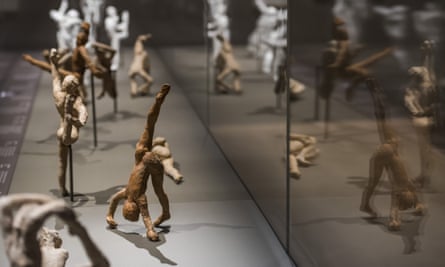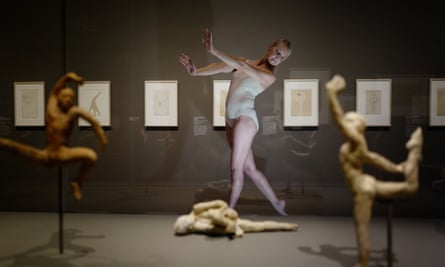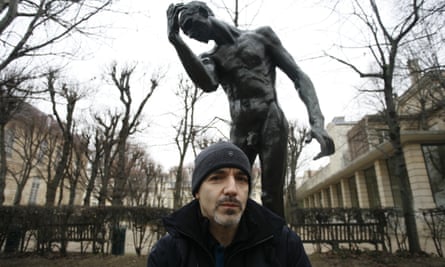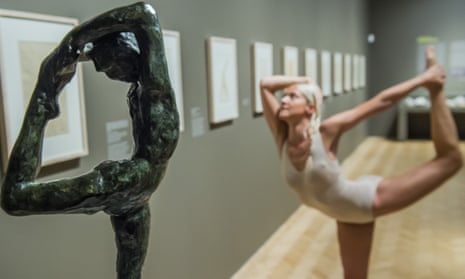When I think of an artist obsessed with dance, it’s Edgar Degas who comes to mind, a figure forever haunting the wings and rehearsal studios of the Paris Opera, trying to capture the elusive, impossible image of a dancer moving through space. Yet dance was no less important to Auguste Rodin, especially in the late phase of his career when he became fascinated by the rich possibilities of shape, tension, musculature and expressiveness contained within the professionally trained body; and inspired by the challenge of representing the dynamics of motion and flight.
The role that dance played in Rodin’s art is explored in a superb cameo exhibition at the Courtauld Gallery, and it’s illuminating to see how widely his response to the subject differed from Degas’ more familiar works. The latter, created mostly in the last three decades of the 19th century, reflect the degree to which Degas was as interested in the social and theatrical context of his models as he was in their bodies. His paintings captured the bleak schoolroom atmosphere of the studio and the heated intensity of the stage, where dancers, lurid under gas light, sweaty under greasepaint, strove to create the illusion of weightlessness and ease.
Even in his most famous dance sculpture, The Little Dancer, Degas brought some sense of back story to the solitary figure of the teenage student. Something in the determined thrust of her chin, the sturdiness of her legs, makes vivid the fact that this precocious child was already a worker, a seasoned professional; we can almost imagine her calculating the odds of making it up the ranks of the Paris Opera, of finding a rich “protector” to supplement her meagre wages.
By contrast, Rodin’s images of dance have little sense of theatre or biography but are stripped back to sinew, flesh, muscle and bone. Nearly all of them have an improvisatory quality, lightning sketches, dashes of colour, sculptures that are roughly finished.

One of the dominating images of the exhibition is that of the acrobat Alda Moreno, whom Rodin sculpted and drew in her signature pose; balanced on one leg with the other touching the crown of her tilted-back head. Rodin was thrilled by the play of angles, the torsion and power of that pose; he enjoyed too the fact that it so frankly exposed the secret parts of Moreno’s body – her breasts, belly and genitalia.
Inspired by Moreno, he instructed his mould-maker to create a series of disparate body parts, limbs, torsos and heads, with which he could play artist-choreographer, assembling these pieces into his own sequence of jumps, stretches, and tip-tilted balances.
Lined up in a glass vitrine in the Courtauld gallery, these Mouvements de Dance make for disconcerting viewing, especially in conjunction with the parallel series of sketches that Rodin drew. Several of the poses here are more like extreme anatomical studies than dance; several have a blatant erotic focus. Yet he himself rebuffed the suggestion that they were an ageing man’s pornography – claiming that he was simply studying the “mathematics” of these naked, acrobatic bodies. More to the point, I think, he was responding with excitement to the liberating physicality that he saw among the new dance forms that were coming into play at the beginning of the 20th century.
While Degas had studied ballerinas, Rodin was enthralled by an emerging generation of dance radicals such as Isadora Duncan and Vaslav Nijinsky, who’d rejected the academic syntax of ballet in favour of a more visceral language of dance; a language that embraced rather than denied the force of gravity, that explored the thrust, propulsion and flow of the body rather than pure decorative line. One of the most telling sketches of this period is of the proto-modern dancer Ruth St Denis, which represents only her uplifted torso and outstretched arms.

Rodin used his (by then significant) influence to champion the careers of these dance pioneers and he was a key figure in supporting Nijinsky during the brouhaha that followed his 1911 ballet L’Apres Midi d’un Faune, when half of Paris claimed to be scandalised by its pagan images of sexuality and its adoption of archaic-looking dance forms. Rodin drew Nijinsky in poses from the ballet and sculpted him once; and the resulting bronze (which was only cast in 1957) is one of the most expressive pieces that has survived of the dancer. In the bunched up force of the curving torso and lifted leg, in the torsion of the neck and in the feral, almost goatish cast to Nijinsky’s features, Rodin captured something of the explosive impact the dancer made when he first appeared on the ballet stages of Europe.

For me it’s the most riveting piece on display at the Courtauld, but there’s one other important strand in this exhibition, which traces Rodin’s interest in a troupe of classical Cambodian dancers who visited France in 1906. While the artist professed to despise the codified language of ballet, he was entranced by these court dancers; by the intricacy and delicacy of their hand movements, and the serenity with which they moved. His beautiful, rapid sketches of these dancers have a distinctive softness and suspension of line in comparison with his images of western bodies; in details such as the inward curl of the hand, the hinge of the foot, the delicate tilt of the head, they also attempt to capture more accurate formal details of style.
The power of Rodin’s response to bodies and movement can be measured by the fact choreographers today have mined his work for their own use. Shobana Jeyasingh, who has created a solo work in response to the Courtauld exhibition, found inspiration in the slippage between the soft Cambodian studies and the harder lines of the western-oriented work. Russell Maliphant, who created a full-length homage to Rodin in 2012, found inspiration not just in the dance pieces, but in all of the artist’s work. Back then he spoke about the choreographic riches he’d encountered, claiming that the six gaunt figures in The Burghers of Calais had been a “lesson in dynamics and grouping”, and that the massive, surreal imagery of The Gates of Hell had forced him to radically rethink his style. To find his own dance variant of “all these figures twisting and falling and pouring through this vertical surface” had, he said, “completely challenged my own vocabulary of movement”.

Comments (…)
Sign in or create your Guardian account to join the discussion